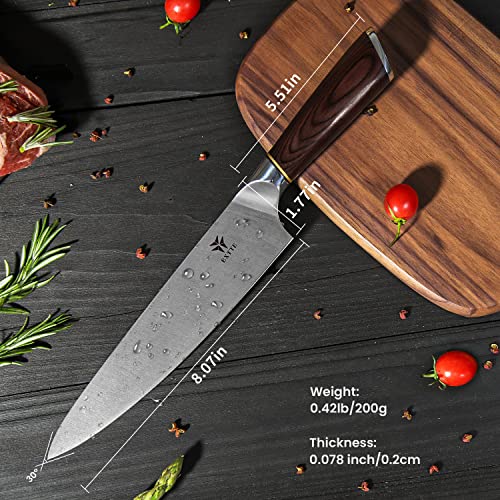Some of you may be weighing up half tang vs. full tang knives, especially since it’s not immediately obvious to know which one is better for the everyday home cook. In this article, we’ll be going over the different knives and various types of knife tangs available on the market.
In particular, you’ll know everything about the various full-tang and half-tang knives on offer and the unique benefits each brings to your kitchen knife.
What is half tang?
A half tang or “partial tang” essentially means the knife’s blade does not encompass the entirety of the knife handle material. Strictly speaking, a half-tang knife means the tang will only extend to about half of the length of the handle, though the term’s meaning has broadened to typically include any knife tang that isn’t a full tang.
Common examples of half tangs include the rat tail tang, skeletonized tang, tapered tang, encapsulated tang, hidden tang, and stub tang.
What is full tang?
A full tang means the knife’s blade extends all the way from the sharp tip through the full length of the handle material and ends at the butt of the knife handle. This type of tang encompasses the full length and width of the handle, so there is no hollow space in the interior.
The knife’s full tang increases its overall weight as more material volume is built into it. This makes knives with full tangs significantly more expensive than half-tang knives.
How are they different?
The clear difference between full tang and half tang is the amount of material used for each tang, which ultimately leads to many consequential differences. A direct implication of the differing levels of material is that full-tang knives are heavier than half-tang knives, which results in further implications.
While the half-tang knife is easier to use due to offering a lighter knife, the full-tang knife offers a stronger cutting edge that delivers more chopping power.
However, full-tang knives tend to have a better balance point that is more centered than half-tang knives, resulting in a better distribution of weight across the knife. With a greater concentration of weight encompassing the entire handle, full tang knives offer a more agile tool that gives the user greater control over their chopping tasks.
Furthermore, full tang knives have a blade extending throughout the knife and grip material. They offer further reinforcement resulting in a blade that is less likely to break under extreme conditions.
Naturally, the differences in material volume result in different craftsmanship practices and hence different costs of manufacturing and retail prices. Since the half tangs are made with less material as the blade only extends partially through the handle, they are easier to mass produce and can significantly reduce their price tags.
On the other hand, the full tang knife blade is more likely to last longer and give you value for money than partial tang knives. They have better balance and extra weight on the handle to offset the pressure from the cutting part of the blade.
How are they similar?
In truth, there are not many similarities when comparing full tang vs half tang, as their designs call for distinctiveness and individuality. On a basic level, however, we can see that full-tang and half-tang knives both connect the blade to the handle.
Furthermore, both half and full tangs act as a continuation of the blade. It extends through the handle materials, offering a sense of security that combines the two entities into one.
What’s better about half tang?
The fact that half-tang kitchen knives use less material than full-tang knives immediately gives them an advantage in cost of production and retail price (1). Those on a budget will relish in the availability of these affordable knives and will have no problem getting most of their tasks done in the kitchen.
The significantly narrower tang also enables easier maneuverability due to the lighter design, reducing the risk of wrist strains and hand injuries.
Another lesser-known benefit of half-tang knives is that they offer a complete seal against moisture, thus preventing the handle materials from expanding. There are also a greater variety of product offerings regarding partial tang knives, as you can get knives with a tapering tang, a rat tail tang, or a hidden tang.
As such, you’ll likely find more ergonomics, aesthetics, and performance options, with most knives comprising partial tangs.
What’s better about full tang?
The great thing about full-tang knives is that their heavy-duty build allows for greater blade longevity. This is because of the thicker and stronger construction around the handle. The point of balance is centered, and the weight distribution is spread more evenly across the blade and handle, reducing the pressure around the blade’s cutting part.
For that reason, full-tang knives are far more suitable for hunting and carving, putting plenty of strain on the steel blade.
Despite its higher price point than half-tang knives, the full-tang knife offers a greater return on investment. A result of the steel blade’s longer-lasting edge and enhanced cutting prowess.
They are also great for tender herbs that require delicate techniques. The weight offset and superior balance enable the pressure to be taken off, preventing you from damaging fragile ingredients.
Interestingly, the full tang knife is more suitable for heavy-duty tasks and harder materials, such as thick meats or wood cutting. The steel blade will not easily bend, chip, or crack under pressure.
Related: Global vs. Wusthof: Which is the better knife investment
Who should get half tang and why?
Half tang is a great choice for those who are on a budget or simply prefer lightweight utensils that are easier to carry around and use. Also, the weight is more forward-balanced with half-tang knives, which are heavier around the cutting part of the blade and lighter around the handle.
The benefit of this is that you can perform tasks like vegetable chopping at an accelerated rate and generally get tedious or repetitive tasks done much faster.
As discussed, fewer materials mean lower production cost; in this case, half-tang knife manufacturers combat the notion of more expensive forged knives. Half tang construction enables premium forged knives to be priced more humbly not by compromising the material quality of the steel but simply by reducing the amount of that steel involved.
Ultimately, half-tang knives suit any home cook looking for more variety in tang designs, and ergonomic handling, and those who may be on a budget.
Related: Forged vs. Stamped Knives
Who should get full tang and why?
The full tang knife is by no means an “elitist” knife reserved only for the wealthy (2). You’ll likely find the most affordable knife brands specializing in full tang knives as well. This is because of the greater demand for full tang knives compared to partial tang knives, which tend not to be as durable or long-lasting.
Thus, the full tang knife is a great choice for those who seek a knife that can last for a lifetime. Regardless of the individual’s budget, there is a full tang knife out there that can meet your demands.
As you may be aware, forged knives are typically more expensive than stamped knives due to their intensive craftsmanship methods. However, just as you can purchase half-tang forged knives at reasonable prices, you can also purchase full-tang stamped knives at reasonable prices.
Keeping that in mind, you can still enjoy the benefits of full tang construction in terms of ergonomics and balance at an affordable price if you go for a full tang stamped blade.
Features
Balance
In terms of durability and a lasting edge, there’s no doubt that full tang is the clear victor over half tang knives. This is more to do with the point of balance rather than the greater amount of materials used in full-tang knives.
By offsetting the pressure away from the blade’s center, you distribute it evenly across the handle and through to the blade’s tip. This means you get a product with all of its elements working together in harmony.
Contrastingly, the half-tang knife has most of its weight around the cutting part of the blade, resulting in a forward-balanced knife that is great for chopping, but inferior for lasting performance.
Winner: Full tang
Ergonomics
The most durable knife is not necessarily the easiest to use. In fact, you’ll generally find a greater level of comfort and security in the grip of a half-tang knife than a full-tang knife. This is because fewer materials in the handle would add to its weight, and there is also a far greater range of partial tang design choices than that of full tang.
Indeed, partial tang knives compensate for their lack of durability by enhancing the speed at which you can chop ingredients through superior ergonomics that puts less strain on the hand during repetitive tasks.
Winner: Half tang
Durability
As mentioned, the differing balance points between the half-tang and full-tang design result in different focus points of pressure for each blade. It is also true that full tang knives are more durable around the handle area as there are no hollow points in their interior, making them less likely to crack or chip if they were to fall on the ground.
Furthermore, the blade of the full tang knife won’t snap so easily as a half tang because the steel is evenly distributed both in terms of length and width, allowing the knife and handle to work as a single entity.
Winner: Full tang
Half tang vs. full tang FAQ
Is full tang better than partial tang?
Full tang knives are not necessarily better than partial tang knives but are not necessarily worst. Both knives excel in different areas, so you’ll find greater durability and balance with a full tang knife, but you may experience a less strenuous and more comfortable cutting session with a partial tang knife.
What is half tang?
A half tang knife is a kitchen knife with its tang (the bottom part of the blade) extending through the handle material but only half its length. Also referred to as partial tang, the half tang blade offers affordability through fewer materials and usability through a lighter design.
What is the difference between a full tang and a partial tang?
The main difference between a full tang and a partial tang knife is the number of materials used in the connecting part of the knife as the blade extends through the handle. Ultimately, the full tang knife uses a full-length and full-width tang that takes on the entire dimensions of the handle with no hollow parts.
Contrastingly, the partial tang only extends partially through the dimensions of the handle, leaving room for a lightweight finish at a lower price.
Is a full tang knife better?
The full tang knife is better in terms of durability and agility as it encompasses an even weight distribution and a stronger handle. Furthermore, the increased presence of steel across the knife results in a heavy-duty knife that can tackle more difficult ingredients such as thick meats or tough pineapple skins.
Sources
(1) – https://corporatefinanceinstitute.com/resources/accounting/cost-of-production/
(2) – https://www.languagehumanities.org/what-is-an-elitist.htm












